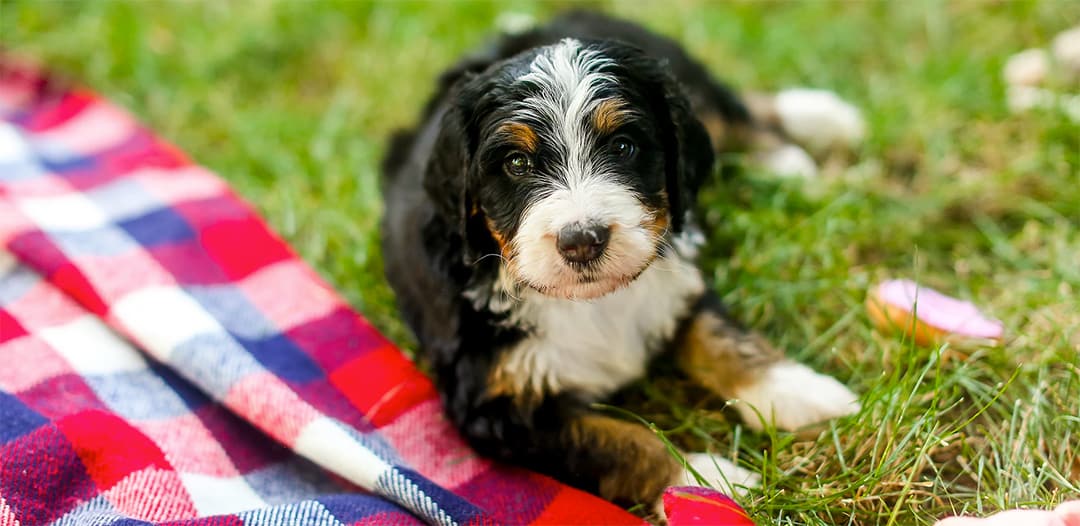The Bernedoodle, a hybrid breed created by mixing the Bernese Mountain Dog (Berner) with a Poodle, has quickly become one of the most popular ‘Doodle Dogs’. Their iconic wavy tri-colored coats bring lots of attention — so prepare yourself to be stopped by inquisitive strangers.
Highlights:
- Bernedoodles were purposely bred to be human companions
- Their low-shed coats make them desirable for those with allergies or an aversion to hair everywhere
- They’re just as happy hiking trails as they are curled up on the couch with you, as long as they’re by their people.
- They are intelligent, loyal, clever, and downright goofy at times
- Bernedoodles are great with people, especially children, but should be well socialized from a young age.
This overview will give you everything you need to know about the Bernedoodle, whether you’re considering adding one to your family, already have, or are just interested in this beautiful breed.
Getting a Bernedoodle? If you’re in the process of researching Bernedoodles, I highly recommend the book “Bernedoodles: A Head To Tail Guide”. Finding the right Bernedoodle puppy can be confusing and costly. In it, Sherry Rupke, the woman credited with creating the Bernedoodle, shares tons of info from selecting the perfect dog to choosing a quality breeder and more.
Table of Contents
Origin and Background
A Brief History
As is true with many other hybrid breeds, the history of the Bernedoodle doesn’t date back that far. In their case, it all starts in 2003 with a Canadian breeder named Sherry Rupke. Sherry started career in 1998 breeding the Bernese Mountain Dog (Berner). She loved the breeds beautiful appearance and character but struggled with the fact that they were predisposed to cancer and hip dysplasia.
Through her own breeding of Goldendoodles (a Golden Retriever-Poodle mix), she saw that when correctly bred, hybrid dogs were typically healthier than their purebred relatives. Sherry began applying what she’d learned from Goldendoodles to her efforts of creating a healthier and more stable version of the ‘Berner’. Her decision to intentionally breed the Bernese with the Poodle was a first or it’s kind. And so was born, the Bernedoodle. It was quite a process achieving the quality, appearance, and health standards she was shooting for. But by 2011, she’d produced the ideal litter, including that tri-color coat that the Bernedoodle has become known for.
As a breeder, Sherry always focused on producing amazing, healthy, family-friendly dogs. And the Bernedoodle was no different. Her sole intention was to create a dog whose only job was companionship. It just so happens that this incredible companion dog goes beyond being your best friend. It brings with is tons of personality, loyalty, and the highly desired trait of a low-to-no shed coat. Making it a great choice for families with allergies.
Bernese Mountain Dog
Its roots go back to the Capital city of Switzerland, Bern, the 2nd largest canton. In this expansive Swiss Alps farmland, Bernese Mountain Dogs (Berners) were charged with herding livestock and protecting them from predators. Even though they’re classified by the AKC as a working breed, they are extremely affectionate, loving, and loyal to their human family.
Berners are a large breed, known for their shear strength. Males range in height (measured at the withers) from 25-27.5 inches and weight between 80-115 pounds, while Females are between 23-26 inches tall and weigh 70-95 pounds. They are a heavy-shedding breed thanks to their thick double coat. And while they have a life expectancy of 7-10 years, many don’t make it that long and succumb to cancer earlier in life. Unfortunately, they are at a much greater risk of dying from cancer than most other breeds.
It shouldn’t come as a surprise but Berners love the outdoors and the cold weather. Bernese tend to enjoy time with humans over time with other dogs. The bond they have with their human family is so strong and they tend to share a special connection with children. Berners are a very adaptable breed and can be found in a variety of places from the agility track running obstacles, to a rehab center working with therapy patients.
Poodle
The Poodle is known around the world as being a highly intelligent breed. And the AKC describes them as “Active, Proud, Very Smart”. Most people are surprised to learn that Poodles were duck hunting dogs in Germany and their breeding as a waterdog dates back over 400 years.
Aside from their intelligence, retrieving skills, and great noses, Poodles are known for their unique coats. They are single-layered, tightly curled, and come in a variety of colors. But most importantly, they shed very little. They are also found in 3 common sizes (which plays a significant part in the Bernedoodles range of sizes):
- Standard: More than 15 inches at the withers, and weighs 60-70 pounds (Male), 40-50 pounds (Female)
- Miniature: 10-15 inches at the withers, and weighs 10-15 pounds
- Toy: 10 inches or less at the withers, and weighs 4-6 pounds
They are quite a versatile breed, attracting owners of all types from the rich seeking a fancily groomed dog, to hunters, and circus’ needing an easily-trained entertainer. Fun fact: Poodles are classified by the AKC as a Non-Sporting Breed, but they are eligible to compete in the AKC Retriever Hunting Tests. They’re the only Non-Sporting breed that can. Poodles are quite lively and need consistent mental stimulation and physical exercise to remain happy and healthy.
Poodles have an average life expectancy of 10-18 years, but are prone to a few diseases/disorders, including hip dysplasia, eye disorders, and epilepsy, to name a few.
Generation Basics
What started as simple breeding between a Bernese and a Poodle evolved into a more complex breeding program that involved generational breeding. Breeders were able to choose the size of the Bernedoodle by mating the Bernese with a specific size Poodle: Standard, Miniature, or Toy.
Through thoughtful and selective breeding, breeders are able to exploit the desired characteristics of each breed and work to eliminate what’s undesired. In the world of cross-breeding, this is commonly referred to as hybrid vigor. It’s through this very process that breeders are able to achieve the traits that make the Bernedoodle such an amazing breed.
Here are some examples showing how generations work:
- F1 – this is the first generation of Bernedoodle, with parents that are purebred Berner and Poodle. The resulting pups are 50% Bernese and 50% Poodle. Result: Likely the healthiest, but not the least shedding.
- F1b – also called a ‘backcross’, this generation is the result of a Bernedoodle being bred back with a Poodle. F1b puppies are 25% Bernese and 75% Poodle.
- F2 generational Bernedoodle is the result of breeding for two F1 Bernedoodles. Puppies from this litter may not have similar traits.
Physical Characteristics
When mixing the Bernedoodle with the Poodle, generally the Poodle’s the father because small Poodles might have difficulty carrying and delivering puppies from a Bernese Mountain Dog. Breeders have used the toy, miniature and standard Poodle. The size of the Poodle used in the breeding generally determines the size of the Bernedoodle. They can range from 10 pounds to 90 pounds and stand anywhere from 12 inches to 29 inches tall at the shoulder. They can also come in a variety of colors and patterns.
Size Differences
Bernedoodle sizes, which are one of three sizes: tiny or toy, miniature or standard, come from the size of the Poodle parent. Toy Bernedoodles are 12” to 17” tall and weight from 10 to 24 pounds. Miniature Bernedoodles are 18” to 22” tall and weigh from 25 to 49 pounds. Standard Bernedoodles stand anywhere from 23” to 29” tall at the shoulder and weigh from 70 to 90 pounds. For whatever reason, males are typically larger than females.
Coat Traits and Differences
Bernedoodle coats come in a variety of colors, patterns and consistency. There’s really no “norm” when it comes to the Bernedoodle coat. One pup in a litter may have a coat that resembles a Poodle while another pup on the same litter can more resemble the Bernese Mountain Dog. They generally have curly, wavy coats that don’t shed very much. This trait often makes them suitable for owners who have allergies to dander.
Although it’s rarer, some Bernedoodles have straight coats. Bernedoodles who have straighter coats tend to shed more and are pose more of a problem for allergy sufferers. Their coat is relatively thick, which provides them with good insulation in both the hot summer months and the cold winter months.
Coat Colors and Patterns
When it comes to the Bernedoodle’s coat color, there is a wide variant of colors. Some Bernedoodles are solid black, some are black and brown, and others are black and white. Some Bernedoodles are tri-colored with patches of white, black and brown. There may even be other colors mixed in the coats. The tri-colored Bernedoodle is the most popular coat color and marking for those seeking a Bernedoodle. Other coat colors and patterns include:
- Sable
- Phantom tri-color
- Parti tri-color
- Bi-color
- Phantom bi-color
- Sable parti
- Merle
Personality and Temperament
Any time breeders are mixing two different breeds of dogs, it’s often difficult to determine what type of temperament or personality the pups may have as adults. Most Bernedoodle breeders tend to be of the belief that these dogs inherit the best personality traits form the Poodle and the Bernese Mountain Dog.
As a rule, Bernedoodles are loyal, affectionate, highly intelligent and have an excellent working drive when needed. Provided they’ve been well socialized, they’re very good with children and with other dogs and animals. Socialization is very important for Bernedoodles. They tend to be shy around strangers unless they’ve been socialized at an early age.
Bernese Mountain Dogs tend to be stubborn at times, and Bernedoodles may inherit some of this stubbornness, which is often most apparent during training. However, much of the stubbornness tends to fade as the dog gets older. Because of their high intelligence, they pick up on commands very quickly.
Care and Maintenance
The Bernedoodle is a loving dog and companion that requires the same type of care and maintenance as any other dog. This includes feeding them a nutritional diet; ensuring they get adequate exercise, grooming them regularly; training them and taking them to the vet for necessary treatment.
- Food – They should be fed once or twice a day with high-quality dog food.
- Exercise – The Bernedoodle should get regular exercise daily.
- Grooming – Grooming for the Bernedoodle includes, brushing coat, cleaning ears, bathing dog and hair clippings.
- Training – A well-trained dog is a happy dog, and the Bernedoodle should receive training starting as young as possible. The earlier the dog is trained, the better the results.
Food Needs
Bernedoodles are known for being voracious eaters that will gulp their food and continue to eat as long as they have food in front of them. Because of this tendency, it’s important to monitor the dog’s diet to ensure he doesn’t consume too many calories and to make sure he gets plenty of exercise. Always feed the Bernedoodle a high-quality dog food designed for the size and age of the dog.
Veterinarians are often able to provide owners with dietary recommendations for the Bernedoodle based on size, weight, age and activity level. Bernedoodles also enjoy treats so make sure to feed the dog healthy treats and snacks. Because of their sensitivity, many owners use treat training, making it even more important to provide healthy snacks and treats. The dog should have access to fresh water at all times.
Exercise Needs
Bernedoodles are a high-energy dog that requires exercise and crave attention. They don’t do their best in homes where they’re left alone for long periods. They’re not particular about the kind of exercise they get as long as they’re with their family members. They enjoy going for walks, playing fetch, swimming, playing catch or just about any activity that has them doing things with their people. Their high intelligence makes interactive games and puzzles particularly interesting to them. They love to use their brains to solve problems. Mental stimulation is almost as important for this dog as physical exercise.
Grooming
The amount of grooming the Bernedoodle requires has a lot to do with the type of coat it has. Generally, the curlier the dogs coat is, the more grooming and maintenance it’s going to require. Because Bernedoodles don’t shed very much, they need to be brushed regularly to prevent matting. Bernedoodles with straight hair tend to shed more, but it’s actually the curly-haired Bernedoodles that need more brushing.
Regardless of what type of coat the Bernedoodle possesses, he will need to be brushed regularly. They don’t need to be bathed a lot unless they spend a lot of time outdoors in the dirt or mud. Bernedoodles should also have their coat clipped every few months to keep it as healthy and clean as possible. Most Bernedoodle owners state they bathe the dog every couple of months or a few times a year. Their ears should be cleaned a couple times a month to prevent ear infections and to ensure they’re kept dry.
Training
It’s very important to begin training the Bernedoodle at a young age. They can begin learning simple commands like “sit”, “down” or “stay” as young as 8 weeks of age. Training sessions for the Bernedoodle puppy should only last for 5 or 10 minutes until they get a little older. They’re a very sensitive dog and respond better to positive reinforcement or treat training.
Housebreaking the puppy can also begin around 8 weeks of age. This is usually the age when breeders let the puppy leave for their new home. Enrolling your Bernedoodle puppy in basic obedience is not only a great way to train the dog but will also provide much-needed socialization around other people and other dogs.
Vet Care
As much as we hate the idea of vet bills, taking the Bernedoodle to the vet for annual wellness checks is the best way to ensure the dog is in good healthy. They need puppy shots, parasite screening, rabies shot and annual vaccination. You might consider taking your pup to the vet just to visit the office and let the dog see that this place is not a place they need to fear. Breeders usually give their puppies the first couple of puppy shots, but the new owner is usually responsible for making sure the dog gets the remainder of the shots.
Health and Common Health Issues
All dogs have some health issues and diseases they’re prone to developing, and the Bernedoodles are no exception. However, Bernedoodles are generally healthier than their parents. Poodles are prone to certain diseases, and Bernese Mountain Dogs are prone to certain diseases. Mixing the two breeds often results in healthier dogs. Although Bernese Mountain Dogs have a high rate of cancer, it’s much lower in Bernedoodles. Overall, the Bernedoodle is a relatively healthy breed of dog. Here are some conditions that Bernedoodles may be predisposed to.
- Hip Dysplasia
- Eye Problems
- Elbow Dysplasia
- Skin Issues (hot spots and allergies)
Tips for Working With A Breeder
Once a person has decided to buy a Bernedoodle, the first step is finding a reputable breeder. This individual will be willing to answer all your questions and will allow you to come to his place of business to view the place and the dogs. The internet is a great place for buyers to search for reputable breeders and reviews on breeders. Here are signs that the breeder is reputable.
- The breeder only sells one breed of dog.
- He or she will provide a health guarantee for the first year.
- Is available to answer all your questions
- Can offer references of other satisfied customers
- Can show you both parents
- Is willing to offer you information (both positive and negative) on the breed
Photo Credit: Cottonwood Creek Doodles





